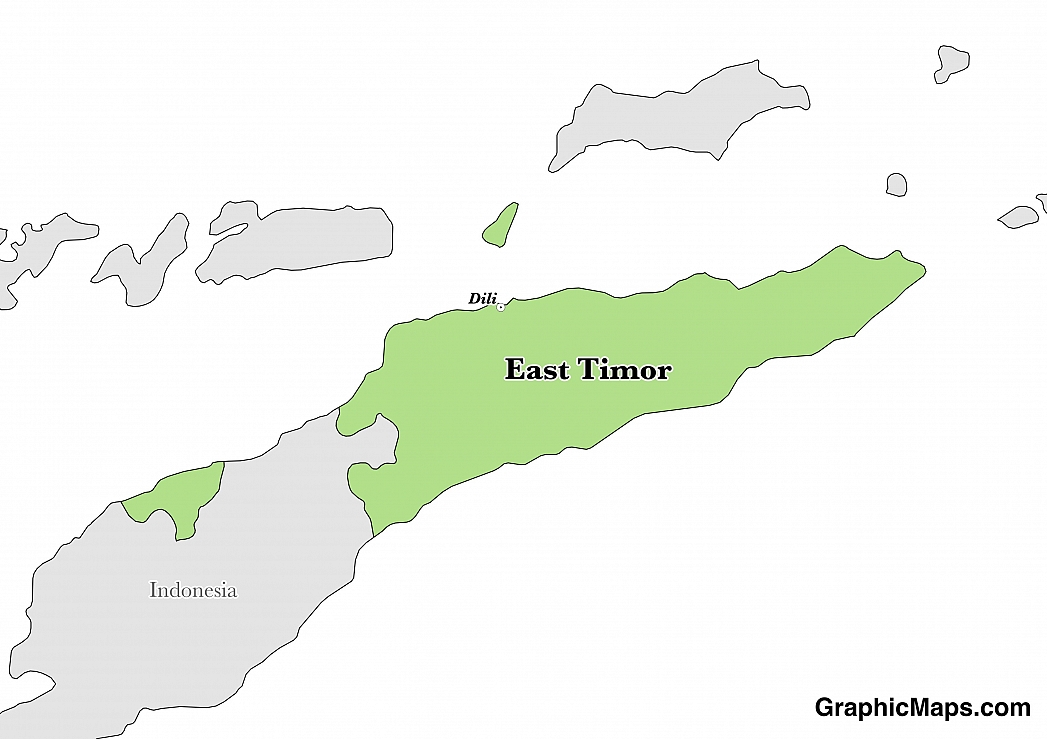Where is East Timor?
Located in Southeastern Asia, East Timor has a 253.00 km border with Indonesia. It has a 706.00 km coastline. There are three stretches of land borders with Timor-Leste that have yet to be delimited.
The capital and most populous city in East Timor is Dili which is situated on the northern coast of the island of Timor. The city was first established in 1520 by Portuguese settlers. It took on the status of capital city in 1769 and then again in 2002 after East Timor gained its independence. With a metropolitan population of 234,331 Dili has a population density of 12,000 people per square mile. Things to see in Dili include the city’s tropical waterfront area as well as its Resistance Museum which chronicles the country’s quest for independence and twenty four year struggle against Indonesian occupation. Dili has a tropical savanna (or wet and dry) climate. Its dry season runs from July to October.
Read more on East Timor's CapitalEast Timor is an Oceanian country covering 14,874.00 km2. This makes it the 41st smallest country in the world and slightly larger than Connecticut. Its geographic coordinates are 8 50 S, 125 55 E and Dili is the capital city.
The name comes from the Indonesian and Malay word "timur", which means "east". "Leste" is the Portuguese word for "east", so the country's name literally means "Eastern-East".
Its ISO code is TL.
Geography
East Timor has a mean elevation of 0 m above sea level.
It has a tropical climate that is hot and humid in the south and semiarid in the north. The terrain is mostly mountainous.
Population
East Timor has a population of 1,261,072 making it the 156th largest in the world. The majority of the population is concentrated in the western third of the country.
Tetun Prasa, Mambai, Makasai and Tetun Terik are all commonly spoken. The majority ethnic group reported is Austronesian. The majority of the country is Roman Catholic.
East Timor’s two official languages are Tetum and Portuguese. Because of its history as a colony of Portugal this western Romance language from the Indo-European linguistic family has played an important role in the country’s culture and evolution. Its alphabet is made up of maximum of two semivowels, nine oral vowels, and 21 consonants. East Timor’s other official language, Tetum, is Austronesian and includes 28 letters. It is spoken by just over 36% of the population while 35% of those living in East Timor are fluent in Portuguese.
Read more on East Timor's LanguagesThe dialing code for the country is 670.
Government
East Timor is an independent country. It gained independence from Indonesia in 2002. Its constitution was last ratified in 2002.
East Timor is classified as a semi-presidential constitutional republic. Its head of state is the President who serves a term of five years in this post. The head of the government is the Prime Minister who, following an election, is appointed by the President as the leader of the political party with the majority of voter support. The nation’s parliament conducts the country’s administrative business in Dili’s National Parliament Building which was renovated in 2002 with the help of financial aid from Australia. The President lives in the prestigious Nicolau Lobato Presidential Palace, also located in the capital city of Dili. Elections in East Timor take place every five years and all local residents 17 years of age and older are eligible to cast ballots and vote for their candidate of choice.
Read more on East Timor's GovernmentEconomy
Factoring in Purchasing Power Parity, East Timor's GDP is $4,975,000,000.00 (USD) with $4,200.00 (USD) per capita. This makes it the 173rd largest economy and its citizens the 169th richest in the world. The currency of East Timor is the Dollar (USD).
Its major imports include food, gasoline, kerosene, and machinery.
Flag
East Timor’s official flag was officially adopted on May 19, 2002 as per its Constitution. The design features a solid red background which symbolizes the country’s struggle for political freedom. Other elements on the flag include two triangles; one black and a thinner yellow version, both of which are positioned on the hoist side and point towards the middle of the design. These features are representative of obstacles which must be overcome as well as the nation’s past under colonial rule. A white five pointed star is depicted inside the black triangle which refers to a guiding light and quest for peace. This version of the flag was adopted during the 1998 East Timorese National Convention which took place in Portugal. This same design had been used years earlier in 1974 after the nation declared its independence in 1974. Other previous flags used included the Portuguese national flag as well as the official United Nations flag.
Read more on East Timor's FlagThis page was last modified on January 17th, 2018
More on Graphicmaps

Published on 2019-11-06
What is a Trade Embargo?

Published on 2019-11-04
Which Two Countries Used to Have the Same Flag?

Published on 2019-09-16
What Is the Only Two-Sided State Flag?

Published on 2019-09-16
Which Country Flag Looks Like the Texas Flag?

Published on 2019-08-29
Flags That Resemble the US Flag

Published on 2019-08-20
